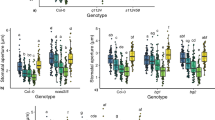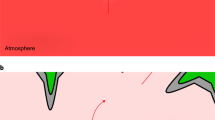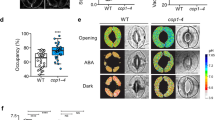Abstract
STOMATTA allow the diffusion of CO2 into the leaf for photosynthesis and the diffusion of H2O out of the leaf during transpiration1,2. This gaseous exchange is regulated by pairs of guard cells that surround each stomatal pore. During water stress the loss of water through transpiration is reduced in response to abscisic acid3, a naturally occurring plant growth regulator which is also present in certain mammals4, algae5 and fungi6, by the promotion of stomatal closure and inhibition of opening7. This involves alterations to guard cell turgor, causing the cells to shrink and thereby reducing the size of the stomatal pore. These changes are driven by cation and anion effluxes8. It has been proposed that an abscisic acid-dependent increase in the concentration of guard cell cytosolic free calcium triggers the intracellular machinery responsible for stomatal closure9(for a review, see ref. 10), but attempts to test this hypothesis by measuring [45Ca] fluxes have produced equivocal results11. Using the fluorescent calcium indicator fura-2, we report that abscisic acid induces a rapid increase in guard cell cytosolic free Ca2+ in Commelina communisL., and that this increase precedes stomatal closure. These results strongly support the sugá-gestion that Ca2+ is an intracellular second messenger in this response.
This is a preview of subscription content, access via your institution
Access options
Subscribe to this journal
Receive 51 print issues and online access
$199.00 per year
only $3.90 per issue
Buy this article
- Purchase on Springer Link
- Instant access to full article PDF
Prices may be subject to local taxes which are calculated during checkout
Similar content being viewed by others
References
Raschke, K. in Encyclopedi a of Plant Physiology New Ser. Vol. 7 (eds Haupt, W. & Feinleib, M. E.) 381–441 (Springer, Berlin, 1979).
Zeiger, E. A. A. Rev. Plant. Physiol. 34, 441–475 (1983).
Davies, W. S. & Mansfield, T. A. in Abscisic Acid (ed. Addicott, F. T.) 237–268 (Praeger, New York, 1983).
Le Page-Degivry, M.-Th., Bidard, J.-N., Rouvier, E., Boulard, C., & Lazdunski, M. Proc. natn. Acad. Sci. U.S.A. 83, 1155–1158 (1986).
Tietz, A., Ruttkowski, U., Kohler, R. & Kasprik, W. Biochem. Physiol. Pflanz. 184, 259–266 (1989).
Assante, G., Merlini, L. & Nasini, G. Experimentia 33, 1556 (1977).
Mittelheuser, C. G. & van Steveninck, R. F. M. Nature 221, 281–282 (1969).
MacRobbie, E. A. C. in Stomatal Function (eds Zeiger, E., Farquhar, G. D, & Cowan, I. R.) 125–162 (Stanford University Press, California, 1987).
De Silva, D. L. R., Hetherington, A. M. & Mansfield, T. A. New Phytol. 100, 473–482 (1985).
Mansfield, T. A., Hetherington, A. M. & Atkinson, C. J. A. Rev. Pl. Physiol. (in the press).
MacRobbie, E. A. C. Planta 178, 231–241 (1989).
Tsien, R. Y. A. Rev. Neurosci. 12, 227–254 (1989).
Clarkson, D. T., Brownlee, C. & Ayling, S. M. J. Cell. Sci. 91, 71–80 (1988).
Bush, D. S. & Jones, R. L. Cell Calcium 8, 455–472 (1987).
Bush, D. S. & Jones, R. L. Eur. J. Cell Biol. 46, 446–469 (1988).
Berridge, M. S., Cobbold, P. H. & Cuthbertson, K. S. R. Phil. Trans. R. Soc. B 320, 325–343 (1988).
Felle, H. Planta 174, 495–499 (1988).
MacRobbie, E. A. C. Bot. Acta 101, 140–148 (1988).
Schroeder, J. I. & Hedrich, R. Trends Biochem. Sci. 14, 187–192 (1989).
Schroeder, J. I. & Hagiwara, S. Nature 338, 427–430 (1989).
Miller, A. J. & Sanders, D. Nature 326, 397–400 (1987).
Weyers, J. D. B. & Travis, A. J. J. exp. Bot. 32, 837–850 (1981).
Brownlee, C. & Pulsford, A. L. J. Cell Sci. 91, 249–256 (1988).
Purves, R. D. Microelectrode Methods for Intracellular Recording and lonophoresis (Academic, New York, 1981).
Williams, D. A., Fogarty, K. E., Tsien, R. Y. & Fay, F. S. Nature 318, 558–561 (1985).
Poenie, M., Alderton, S., Steinhardt, R. & Tsien, R. Science 233, 886–889 (1986).
Brownlee, C. Biol. Bull. 176(s), 14–17 (1989).
Tsien, R. Y. & Rink, T. J. Biochim. biophys. Acta 599, 623–638 (1980).
Williamson, R. E. & Ashley, C. C. Nature 296, 647–651 (1982).
Author information
Authors and Affiliations
Rights and permissions
About this article
Cite this article
McAinsh, M., Brownlee, C. & Hetherington, A. Abscisic acid-induced elevation of guard cell cytosolic Ca2+ precedes stomatal closure. Nature 343, 186–188 (1990). https://doi.org/10.1038/343186a0
Received:
Accepted:
Issue Date:
DOI: https://doi.org/10.1038/343186a0
This article is cited by
-
Cucumber Phospholipase D alpha gene overexpression in tobacco enhanced drought stress tolerance by regulating stomatal closure and lipid peroxidation
BMC Plant Biology (2018)
-
Overexpression of annexin gene AnnSp2, enhances drought and salt tolerance through modulation of ABA synthesis and scavenging ROS in tomato
Scientific Reports (2017)
-
Xylem sap calcium concentrations do not explain liming-induced inhibition of legume gas exchange
Plant and Soil (2014)
-
Drought-induced H2O2 accumulation in subsidiary cells is involved in regulatory signaling of stomatal closure in maize leaves
Planta (2013)
Comments
By submitting a comment you agree to abide by our Terms and Community Guidelines. If you find something abusive or that does not comply with our terms or guidelines please flag it as inappropriate.



